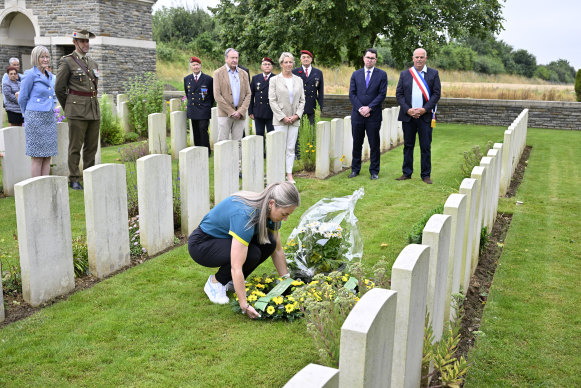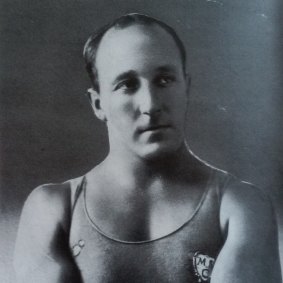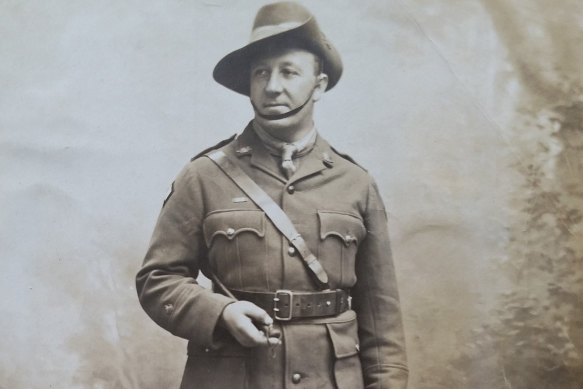By Rob Harris
Assevillers, France: After Cecil Healy was shot and killed while leading his platoon during the Australian attack on Peronne on August 29, 1918, his friend, Major Syd Middleton, wrote to his father and brother.
“By Cecil’s death the world loses one of its greatest champions, one of its best men,” the gold medal-winning Olympic rower and captain of the Wallabies before the war wrote. “Today, in the four years I have been at the front, I wept for the first time.”

The Australian Olympic team’s deputy chef de mission Kaarle McCulloch places a wreath on the grave of Cecil Healy in Assevillers, northern France. Credit: Kristy Sparow/Getty Images
Six years earlier Healy achieved Olympic glory at the Stockholm Games, winning gold in the 4x200-metre swimming relay. But he would be denied a famous double when he performed what has been described as one of the greatest acts of sportsmanship in the movement’s history.
Healy had insisted that race favourite Duke Kahanamoku be allowed to compete in the 100m freestyle final despite the American champion missing his semi-final because of an apparent mix-up. The Duke was allowed to swim and won gold. Healy took the silver medal.
After the presentation, Kahanamoku sought out Cecil, lifted up his arm and declared: “this is the true Olympic champion”.

Swimmer Cecil Healy is the only Australian Olympic gold medallist killed at war.Credit: Collection of John Devitt and Larry Writer
In a far-flung field in northern France on Wednesday the life and achievements of Healy were honoured by the athletes he inspired and by those whose village he and his men once liberated.
Assevillers, now a village of 300 people about 130 kilometres north of Paris, was occupied by the Germans twice during World War I before it was finally retaken by the 5th Australian Division on August 28, 1918. The following day Healy was leading his platoon, clearing out German machinegun posts when he was shot in the neck and chest. Just 74 days later the war would be over.
He remains the only Australian Olympic gold medallist to be killed in combat.
“Cecil Healy’s memory is a powerful presence here,” says Australian Olympic team deputy chef de mission Kaarle McCulloch, a former world champion track cyclist.
“What stands out is his leadership, his bravery and his sportsmanship. And of course, he was such a wonderful athlete. What a tragedy that he lost his life at a young age with the First World War coming to an end.”
McCulloch and 1980 gold-medal swimmer Michelle Ford laid wreaths on Healy’s grave. The pair were joined by Assevillers mayor Didier Jacob, Australia’s ambassador to France Gillian Bird and Patrick Gorman, the assistant minister to the prime minister.
Sand from his beloved Manly beach, flown over for the occasion, was sprinkled beside his headstone.
“It took a lot to go beyond our shores to Europe during a troubled time for the world to compete at the Stockholm 1912 Games; paying his own way also,” said Ford, who won gold in the 800-metre freestyle at Moscow in 1980. “I wanted to be part of this today to join the AOC and recognise someone who really stood for all the Olympic values.”
Healy crammed plenty into his 36 years. In swimming, he was an early proponent of the new crawl stroke and the side-breathing technique. A lifeguard at Manly beach, he was honoured for his bravery in several rescues.

Cecil Healy, killed in the battle of the Somme, served with the Australian infantry in France in World War I.Credit: Collection of John Devitt and Larry Writer
And his friendship with “The Duke” would lead to one of the pivotal moments in Australia’s sporting life. In 1914, Healy invited him to Sydney, and he brought his surfboard, performing a number of exhibitions over the summer, most famously at Freshwater Beach in front of hundreds of spectators.
The nation had fallen in love with surfing for the first time.
In France, the victorious battles fought by Healy and his men in the bloody battles of the Somme have never been forgotten. His statue stands outside the town hall as a reminder of the Australian contribution.
Local science teacher Bertrand Fareneau researched Healy’s background in 2016, leading to the commissioning of the statue.
“We are privileged to have him resting alongside so many brave men here,” he says. “I think you can see we will never let his memory or his achievements be forgotten.”
Get a note directly from our foreign correspondents on what’s making headlines around the world. Sign up for the weekly What in the World newsletter here.